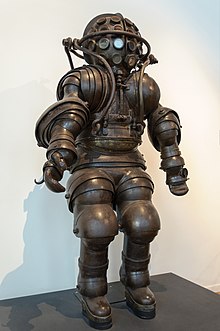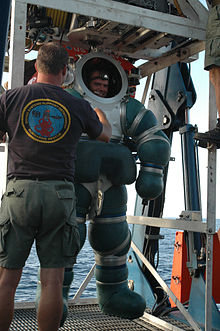Armored suit
The armored diving suit is a special form of a diving suit or a movable one -man submarine . The suit is rigid and there is no pressure equalization with the surrounding water pressure. The mobility of arms and legs is created by special joints that internally balance the pressure. Since it is not possible to use the hands, grippers are used as manipulators.
In contrast to scuba diving can and could, even without the use of saturation diving techniques and gas mixtures , early greater depths can be achieved and the cost is comparatively lower. There is surface pressure in the suit itself, no decompression is necessary. The primary and secondary (for emergencies) breathing apparatus is usually an oxygen circulation device . Throwable weights provide an emergency ascent option , the suit, including the diver, is lighter than water thanks to the air it contains, and it floats.
In English literature, the technology also appears under the terms hardsuit and atmospheric diving suit . The descriptions Armored Diver and Iron Man , on the other hand, may be of literary origin. The term scaphander , which is also used , generally designates a pressure or protective suit, which often means regular helmet diving equipment or a pressure suit for flying.
history
precursor
- With early helmet diving suits (and their designs) there were technically and physically pointless attempts to “armor” the “soft” suit against water pressure and all sorts of water creatures.
- Wooden closed dipping barrel by John Lethbridge , England, 1715. The work was done with exposed arms and leather seals on the upper arm. In tests with a replica barrel, the water pressure turned out to be very painful, the diving depth was limited to about 20 meters. The suit proved itself in 1725 during successful mining work on the ship Slot Her Hooge of the East Indian company .
- Armored suits were designed by the Canadian Philip in 1856, others by the Americans Bowdoin (1915) and Campos (1922). As far as can be assessed, the drafts would not have been technically or physically functional.
- The iron man of the Italian rescue company Quaglia was a pure observation chamber in the form of an upright cylinder with a wreath of numerous portholes . Entry into the pressure-resistant chamber was via the head, breathing, as with later suits, via an oxygen circulation device. A weight anchor and a telephone connection enabled salvage work on the freighter Egypt , which sank in 1922 , which lasted from 1930 to 1935 and was carried out mainly with shovel grabs and explosives from the surface.
Early types
- The fully closed suit of the French Carmagnole brothers from 1882 has semicircular joints sealed with textile loops. The view in the spherical head part was ensured by 20 small portholes. The suit was still too flawed for practical use; it is now in the Navy Museum in Paris.
- Two suit constructions for the German Navy come from the German company Neufeldt and Kuhnke . Despite weaknesses in the joint construction, various suits from the company could be used in Germany and Russia from 1917, and later also in America. A depth of around 170 meters was reached, and the idea was to use it in submarine rescue, among other things. The second version of the suit has a cylindrical, rounded head part that also serves as a (screwed) entry and suspension point. A larger, central porthole serves as a view in addition to several small ones, while a buoyancy tank at waist height complements the construction. The one-piece, downwardly angled links appear bulky and relatively straight compared to the later Galeazzi construction. The first version of the suit differs in many ways from the later ones. The cylindrical suit is divided into two parts, entry is through the hips, the buoyancy tank is at head height. The articulated arms are mounted horizontally and show a certain similarity to the later Peress construction. The German suit was used in the attempted rescue or recovery of the British submarine M1 , but the boat could not be found in the end.
- The Italian Galeazzi successfully brought out several improved own models based on the German construction. The suits have a streamlined, rounded, modern shape; the body of the suit, including the “belly base”, is made up of two eight-figure spheres. The head entry is rounded outwards in order to better withstand the external pressure. Legs and arms are each one-piece and curved, designed as spherical caterpillars. A "nose" with further portholes helps with the view downwards.
- The American Peress experimented with various joint designs from 1922. One suit was completed in 1930, tested by the Royal Navy , and finally retired in 1937. Jim Jarret dived to the RMS Lusitania with this model in 1935 , the tested depth was 120 meters. The articulated, misshapen-looking arms are stretched forward on the cylindrical trunk, the oxygen supply is on the outside. A float tank corresponding to the German suits is missing.
... to make the wreck of the Lusitania .
Well-known types used today
- JIM (first version): British development from 1969, named after the diver Jim Jarret. First fully functional and versatile suit. Four large portholes similar to helmet diving equipment are located in the massive round head piece; this can be tilted at the entrance of the diver. Large spherical joints on arms and legs with internal oil pressure compensation.
- JIM (following version): Improved version (s) of the JIM suit. Crawler-shaped articulated arms with numerous small articulated segments, glass hemisphere for a view. Diving depth around 300 meters.
- WASP : The cylinder-shaped fuselage features a visual hemisphere and caterpillar-shaped articulated arms, as with JIM. There are no longer any legs, propellers ensure that this near-submarine moves forward.
- NEWTSUIT (Phil Nuytten Canada, Dräger , known commercially as Hardsuit ): Body-hugging suit development for 350 (type 1) and 600 meters (type 2) diving depth. A large number of rotary joints results in greater mobility; the suit can be adapted to different body sizes with spacer elements. The view is through a large arched panorama porthole (Cyclops); Additionally mountable propellers allow greater mobility under water. Further developments of the Newtsuit are the Quantum II (OceanWorks), the ADS2000 (US Navy) and the Exosuit (Phil Nuytten, Nuytco Research).
Use today
Armored diving equipment can be seen today in economic and technical competition to the remote-controlled ROVs , the regular work submarines and the saturation diving . Each form has specific advantages and disadvantages in terms of price, availability, the one-time and ongoing effort and the actual form of use.
The current depth record with an armored diving suit was set by Daniel P Jackson on August 1, 2006 as part of a US Navy test program. He dived 610 meters (2000 feet) deep.
See also
Web links
- Article on applications and history of the armored suit by Mike Thornton, Dr. Robert E. Randall and E. Kurt Albaugh in Offshore magazine, January 1, 2001, accessed July 2, 2020.
Individual evidence
- ^ Diving suit has futuristic look, but graceful underwater, Eric Berger, Houston Cronicle, May 2, 2012 . Tuesday 2nd June 2020
- ↑ The US Navy ADS2000: Beginning a New Era in Submarine Rescue, Jim Gibson & Jim English, Ocean Works Intl. Corp. . Tuesday 2nd June 2020
- ↑ Hardsuit 2000: How the US Navy has Adapted the HS2000 for Submarine Rescue, Daniel Jackson . Tuesday 2nd June 2020
- ↑ Exosuit . Tuesday 2nd June 2020
- ↑ Mark G. Logico: Navy Chief Submerges 2,000 Feet, Sets Record. US Navy, August 4, 2006, accessed January 15, 2017 .










